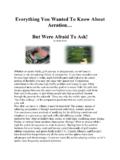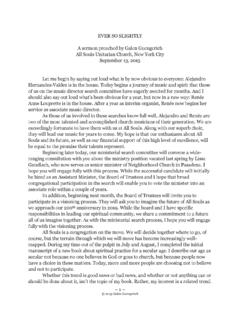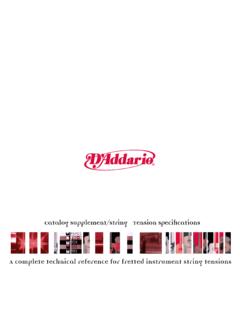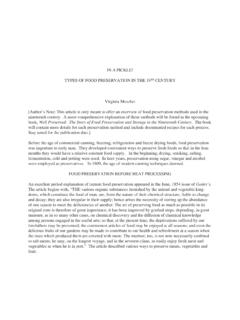Transcription of T FABRICATOR® Everything you need to know about …
1 Provided by: Welded Tube Pros LLC, Doylestown, OH. Tel: 330-658-7070 Email contact for Eric Theis: THE FABRICATOR Everything you need to know about flatteners and levelers for coil processing -- Part I How flat-rolled metal gets unflat By Eric Theis, Contributing Writer October 10, 2002 This is article is part 1 of a four-part series covering flatness and stability in cut-to-length, slitting, and tension leveling operations. This article covers how flat rolled metal gets unflattened, including the 3 categories of defects, how defects are created at hot and cold mills, and how coil processors also create defects. Photo courtesy of Atlas Steel Products Co., Twinsburg, Ohio. Does your coil processing operation preserve or improve quality?
2 Do you struggle just to keep the quality the mills put into their flat-rolled products, or do you have equipment that can upgrade quality and add further value to your coil processing operations? To maintain material quality, first we must understand flat-rolled metal defects and how people and processes can cause them. Types of Shape Defects Three categories of flat-rolled shape defect exist, and resolving each requires a different approach and equipment configuration. In ascending order of complexity, the three categories are: 1. Surface-to-surface length differential. This includes coil set (see Figure 1) and crossbow (see Figure 2), which are related problems. 2. Edge-to-edge length differential. If the edges are longer than the center, you will have wavy edges (see Figure 3).
3 If the center is longer than the edges, you will have center buckle (see Figure 4), sometimes called oil can or canoe. This category of defect also includes camber (see Figure 5) and twist (see Figure 6). Coil set is a type of surface-to-surface length differential defect. Edge wave, buckles, and camber are easy to understand. Twist is a little more difficult to visualize as an edge-to-edge length differential issue. If we unwind a twisted strip, we'll see that the edges and center have different lengths, depending on the geometry of the twist, or helix. Twist is not simply coil set up on one side and down on the other side. A twisted strip has a side-to-center-to-side length differential that, unlike edge wave, continues all the way across the strip.
4 3. Surface-to-surface thickness differential, or crown (see Figure 7). This is a common problem for slitters, and it will be discussed in Part IV of this article. Flatteners or levelers can't reduce crown significantly because their work rolls are offset. It takes a rolling mill with opposed rolls to do that. This article discusses the causes of crown, but not how to eliminate it. Crossbow is another type of surface-to-surface length differential defect and is related to coil set. Sources of Shape Defects The mills have come a long way in the last few years in controlling shape and thickness, but perfection is difficult. You need to understand this--not because you're going to be in the rolling mill business, but because you must be realistic when talking to the mills about your expectations for product quality.
5 The producer mills would like to make crown-free flat-rolled coils every time if they could. If they miss that goal, they much prefer a thicker center for tracking purposes, so the coil runs straight through the mill stands. If the edges are thicker than the center, the coil won't go straight. At the Hot Mill At the hot mill the crown or thickness profile can be changed without changing the shape or flatness, and vice versa. Hot mills try to get the relationship between crown or profile and shape, but achieving both perfect shape and perfect crown control is almost impossible. With new automatic gauge control (AGC) technology, the mills are doing much better, but perfection remains an elusive goal. At the Cold Mill At the cold mill, every time we change the thickness profile, we also change the flatness.
6 The cold mill roll gap should start out being set to the same profile as the crown of the incoming hot mill product. Then, as the cold mill gap is adjusted to reduce the crown, the coil also will come out flat--if the hot mill got the relationship between crown and flatness right to begin with. Wavy edges are an edge-to-edge length differential defect and are created if the edges are longer than the center. If the cold mill rolls or hot mill coils have too much crown, the mills will roll out the center, creating center buckle in the process (see Figure 8). If the cold mill rolls or hot mill coils have too little crown, the mills will roll out the edges and create edge wave (see Figure 9). This is fairly common in mill master coils.
7 Mill work rolls and backup rolls bend and compress under the vertical loads it takes to reduce plate or sheet coil thickness. In theory, if the work roll surfaces were absolutely parallel, the top and bottom surfaces of the rolled product would be parallel--no crown. But the fact is that Everything is deflecting under the rolling loads and so it doesn't work that way. The mills deliberately crown their work rolls slightly larger in the center to allow for deflection and compression under load. The amount of roll crown that is added is a compromise, a best guess. In addition, mills can control the gap profile by bending these huge rolls or by expanding them with hydraulic pressure like a huge steel balloon. Center buckle, another type of edge-to-edge length differential defect, is created when the center is longer than the edges.
8 You've probably seen the pictures of the mill control pulpit with all its controls and computer monitors. Every time the operator pulls a lever, he changes what's going on at that mill stand and, therefore, the amounts of deflection. The hot mill's strategy is to get the relationship between crown and shape correct so that they will both come out right in cold rolling. If that sounds difficult, it is! Figure 5 Camber is an edge-to-edge length differential defect. The tension on the coil strand through the mill also affects the thickness reduction at the mill roll. It shouldn't surprise us then if that the heads and tails of the mill coil are thicker than the middle because they did not have full tension. Problems Aren't Only in the Mills Do you remember Pogo?
9 Pogo was a small opossum and a great philosopher--in the Sunday newspaper comics! He once said, "We have met the enemy and they is us!" Well, sometimes we are our own enemy--because shape defects can be induced at any stage in processing of the coil, and we're all part of that. How many metal buyers would like to specify coils without coil set? The problem is that coils are in coil form. Most coils have a 20- to 24- inch ID. In most cases, unless the metal is very thin or very hard, coil processors put coil set back into the material during the recoiling process. The producer mill's leveling equipment can make the material dead flat, but then the metal is recoiled for shipment to you, and that puts coil set back into it.
10 Where does coil set come from? It's in the coil! Coil set should be more pronounced on the coil's inside wraps and less on the outside because the inside bend radius is smaller. In fact, it's possible to have residual reverse coil set in the outer wraps from the original master coil before it was swapped head to tail in some previous operation. We also can induce reverse coil set during our own uncoiling process by backbreaking the material over a small breaker or passline roll. Twist also is an edge-to-edge length differential defect. How many coil processors can use a 60,000-pound master coil straight from the rolling mill? Somebody has to pickle it, anneal it, coat it, slit it, and perhaps cut it to a smaller OD.





